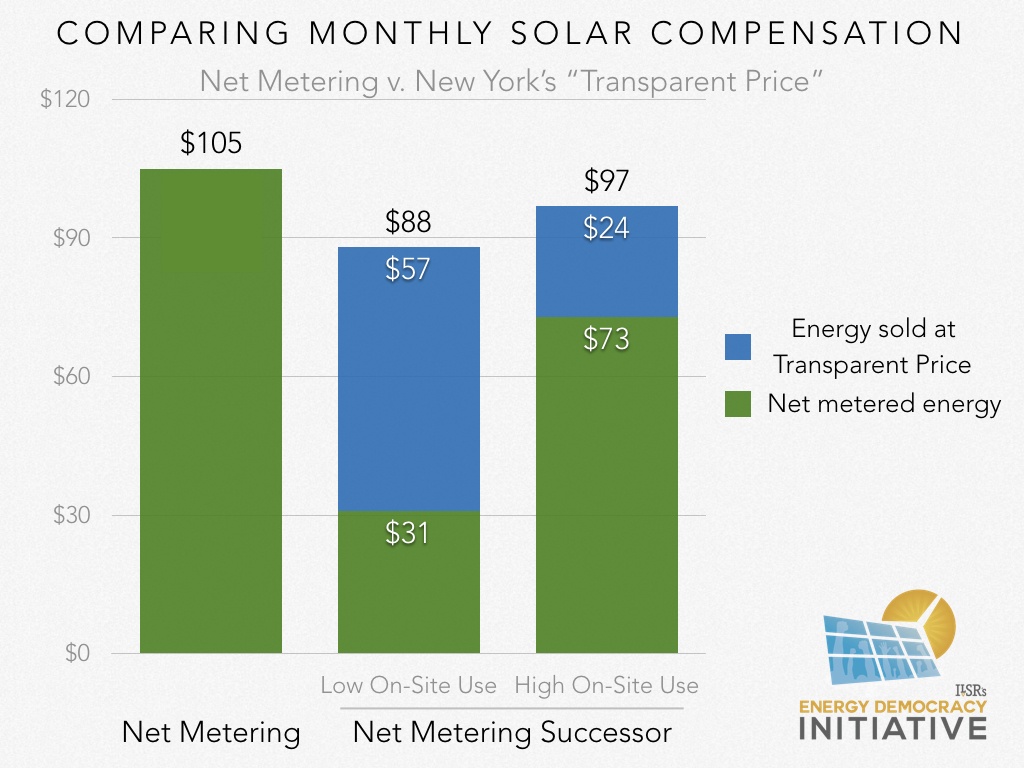Electric Vehicles Report: Part 3 — Changing Rules To Maximize Electric Vehicle Benefits

Sign up for daily news updates from CleanTechnica on email. Or follow us on Google News!
The following is an excerpt of the Institute for Local Self-Reliance’s Choosing the Electric Avenue: Unlocking Savings, Emissions Reductions, and Community Benefits of Electric Vehicles report. We’ll be republishing the full report in order to bring more attention to the changing landscape of electric vehicles. Read parts one & two.
With a virtuous cycle of falling battery costs driving increased electric vehicle deployment, and deployment improving the economics of scale of battery production, the widespread adoption of electric vehicles is likely inevitable. But policies enacted now could influence the timing of widespread use and shape how electric cars benefit the grid. The following section explores how policy can most effectively aid adoption of electric vehicles, in a way that maximizes their economic benefits to the grid and to vehicle owners.
Deploy Charging Infrastructure
Simplifying refueling with widespread vehicle chargers is key to capturing electric vehicle benefits. This means placing chargers strategically and offering sufficient charging speed to match the battery capacity and time available to charge.
For many individual vehicle or even fleet vehicle owners, charging while parked overnight will replace today’s regular visits to the gas station. Typical 120-volt outlets can fully charge cars with a smaller battery (like in the Nissan Leaf), from empty to full, in about 12 hours. However, the next generation of electric vehicles — the ones that will compete directly with internal combustion engines — need more power to refuel completely and quickly.
Charging infrastructure will also need to be available where people park, and not everyone has a handy garage or carport. In a presentation to the California Energy Commission, Nissan noted that fewer than half of today’s 140 million light-duty vehicles have a garage stall available. Over 60% of U.S. residents live in multi-unit housing that may lack charging options, and few workplaces or public spaces today feature vehicle chargers.
The local refueling network for electric vehicles will be substantially different than for gasoline vehicles. Many cars will charge at home overnight, only rarely requiring a public charge. Many more will want access to overnight charging when parked on-street.
This section explores charging infrastructure issues. It begins with long-distance travel, where high-voltage chargers will largely mimic the existing gas station network, then dives into the novel places that will need fueling infrastructure to accommodate a new electric fleet. Finally, it discusses the role of competition, incentives, cities, and autonomous vehicles in building out of electric vehicle charging.
For Long-Distance Travel
High-capacity charging to support long-distance travel is likely to follow the private market model for fueling gasoline-powered vehicles. Charging locations will be determined by vehicle battery capacity and commonly traveled routes. Already, Tesla has built a national network of 145-kilowatt “Superchargers” for its vehicles (shown below), which provide its vehicles 170 miles of range in about 30 minutes. Private company ChargePoint also provides high-voltage 50- to 400-kilowatt “Express Plus” chargers that offer fast charging for all electric vehicle models and are designed with future, higher capacity batteries in mind.
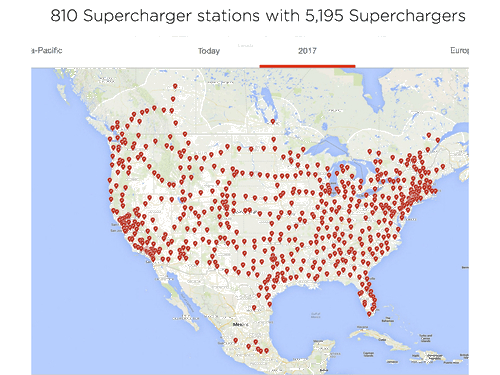
At Homes and Businesses
Placement of chargers in cities may follow different development models, and there’s a compelling case for utilities to be more heavily involved. While typical 120-volt outlets are ubiquitous in homes and businesses, they have two major drawbacks. First, they charge car batteries in hours, not minutes. Second, they tend to be in or attached to buildings, limiting charging options for those who park on the street or away from buildings in parking lots. The solution to both issues is deploying higher-voltage chargers wherever drivers park.
We’ll start with the simplest case: a driver who can park in a garage or driveway close to a building. In a scenario where their car battery has sufficient range and they plug in each night, a typical 120-volt outlet may be sufficient. But for those who want a faster turnaround either for multiple trips in a day, or simply the security of having a full battery sooner, a higher-voltage charger is desirable. For these folks, the barrier is the personal financial cost of such a charger, which usually runs around $1,200 for hardware and installation, split evenly between the charger and the cost to run a higher-amp, 240-volt wire to the charging location.
There’s a compelling case for electric utilities to pay for these chargers, and there are a couple of mechanisms for doing so. One is to provide inclusive, tariff-based financing. Under inclusive financing, the utility fronts the money for energy efficiency or renewable energy improvements (including electric vehicle chargers) on a customer’s property, then recovers the cost over time through the customer’s electricity bills. The timeline for cost recovery provides the customer positive cash flow from day one, but caps repayment costs at 80 percent of the total cost reduction. In this case, since there are no attributable energy savings (on the electric bill, though there are substantial savings at the gas pump), the term could correspond instead with the typical ownership period of a car, about six years.
A second financing option is traditional cost recovery, where the utility pays for the chargers but spreads the cost over the entire customer rate base.
In either case, the long-term revenue stream from electric vehicle charging justifies utility-managed financing. This is a similar approach to giving away light bulbs to drive sales in the early years of electrification. Utilities will see significantly greater revenue from electric vehicle charging. With typical driving patterns, the average household consumes an additional 4,000 kilowatt-hours per year after buying an electric vehicle. The incremental cost to the utility for delivery that energy is minimal, especially if charging plans reward the car owner for avoiding peak energy periods.
If a customer charges their car at the average retail rate of $0.10 per kilowatt-hour (assuming 30%, or $0.03, covers the fuel costs for generation), the utility would recoup the $1,200 cost of a home charger in a little over 4 years, less than the typical six years duration of vehicle ownership. Even at a discounted charging rate of $0.03 per kilowatt-hour for off-peak charging, the utility would recover the charger cost within 10 years. This may suffice, as it seems unlikely that customers will transition away from electric cars after owning one.
In Public Places Near Residences
Placing public charging stations near multi-family buildings or other residences lacking off-street parking is more complicated. For one, how can parking spots adjacent tor chargers be reserved for electric vehicles, especially in neighborhoods where parking spaces come at a premium? For another, how each charger support multiple vehicles if the tendency is to park the cars and leave them charging all night? The economic case for installing public on-street charging is strong if they are well-utilized.
If a pair of electric vehicles with 30 kilowatt-hour batteries were to park and completely refuel at a dual charger 300 nights per year at a cost of $0.05 per kilowatt-hour, the utility would recoup a total of $900 per year. That translates to a seven-year payback on the $6,000 public charger.
Chargers at businesses, built to serve customers or employees, might be simpler to integrate than on-street public chargers. Utilities may find an advantage in having these charging stations available to absorb daytime solar production, or for providing ancillary services to the larger grid. Businesses may simply offer charging as a convenience to attract customers, a benefit for employees, or as a tool to tap potential energy savings. In the latter case, customers could agree to make their batteries available briefly to help reduce the building owner’s peak energy use (perhaps in exchange for a discount in store).
No matter the method, private charging infrastructure will likely expand quickly as home or business owners purchase electric vehicles. Still, the charging logistics for those without off-street parking remains a challenge.
In Commercial and Other Spaces
Charging in public spaces (apart from residential locations) offers a less compelling economic case, but it may also prove less necessary in the long run. While existing electric vehicle owners may target a midday charge for evening errands or longer commutes, the next generation(s) of drivers are unlikely to need refueling beyond overnight charging. In the near term, however, there’s an opportunity to use public charging stations to encourage electric vehicle adoption and a craft a compelling economic case to finance them.
At a cost of about $6,000 per public charger (for dual charging stations), the utility would have to spread the cost over more customers than they would for home chargers.
Aiming for a 10-year payback on public charging, the utility could finance a public dual charger for every 15 electric vehicle drivers. This assumes about $450 per year in revenue from each public charger (charging 25 kilowatt-hours per day at $0.05 per kilowatt-hour, and that the home customers are providing $120 per year each charging at $0.03 per kilowatt-hour). The utility uses the revenue to cover the cost of a Level 2 charger for each customer, plus the public station.

Deploying new public infrastructure is important. Nissan notes the number of public chargers per electric vehicle has slipped significantly in the last two years, from four cars per charger to over 14 cars per charger. This framework would reduce number of vehicles per public charger to 7.5 and remove the home charger cost barrier from electric vehicle ownership.
Utilities theoretically have the reach and scale to build out comprehensive networks across their service areas. At least one — California’s largest, Pacific Gas & Electric Co. (PG&E) — received regulatory approval for a proposal to add up to 7,600 charging stations across its 70,000-square-mile territory, at a total cost of up to $130 million.
A more expansive public charger network, like the one originally proposed by PG&E in California (with 25,000 Level 2 chargers and 10 fast chargers), would likely encourage electric vehicle ownership. But the larger PG&E proposal spotlighted questions about who bears the cost, and why it’s relatively high. Under PG&E’s plan, customers would cover the project’s $130 million price tag for charging stations (at a cost well over $15,000 per station). Consumer advocates raised concerns about the size and price tag of the project, and suggested a smaller pilot program to gauge benefits that come with more widely available charging stations. Although utility costs can be recouped by higher electricity sales, it’s important to get the price right, too.
Two other large utilities in California received approval for smaller charging station rollouts, at a smaller per-station price. San Diego Gas & Electric Co. will install 10 chargers each at 350 locations — including businesses and multifamily housing complexes — and implement special rates that reward drivers who plug in when solar generation is most abundant. The project will cost $45 million. Southern California Edison, meanwhile, plans to add 1,500 charging stations in a $22 million project. It will prioritize locations like workplaces and campuses, where drivers typically park for longer periods of time.
Public charging infrastructure can also be deployed with an eye toward equitable access. San Diego Gas & Electric Co., for example, plans to install 3,500 total public chargers and place 10 percent of them in disadvantaged communities. These chargers are a crucial complement to state incentives designed to increase ownership among lower-income Californians.
Charging “Depots”
Charging “depots,” where a fleet of electric vehicles can charge simultaneously in a single location, can provide a ready-made demand response resource.
These facilities could serve battery-powered taxis and commercial vehicles, as well as accommodate vehicles parked at workplaces. Solar panels atop charging depots could provide power, while locating them near substations could minimize power delivery costs. This system follows a method tested by Nissan at a Japanese office building, where the battery power held by six plugged-in Nissan Leafs enabled the automaker accommodate high demand and avoid peak charges.
The key for public depots is providing an incentive for fleet vehicles to stay plugged in. A taxi driver, for example, is unlikely to wait around longer than is necessary to fuel up for their next fare. On the other hand, autonomous vehicles (discussed later) may be the perfect match for these facilities.
Competitive Issues
Despite the logical overlap between electric vehicle charging and utilities, some private charging network operators have decried the use of ratepayer funds to support charging infrastructure, citing fair competition. It’s a challenging policy question in an era in which most technology lends itself to decentralization and greater competition. However, adding electric vehicle chargers is much like stringing the first wires — there’s a reason to avoid unnecessary duplication. One possible remedy is to prohibit monopoly utilities from installing chargers. This would require significant development of policies and protocols to ensure that private stations could interface with utility systems and allow for managed charging, but it may follow the direction of decentralization of energy generation already in motion.
Another option is to allow utilities to manage and finance a charging station rollout, but have regulators set competitive requirements. For example, regulators should require the utility to buy and install a variety of charging hardware, to test out different technologies. This method was recently proposed in comments filed in relation to an electric vehicle tariff program pilot in Minnesota. Another key element is “rolling qualifications,” or flexible purchasing standards that allow new charging hardware to qualify for build-outs that have already received approval, without having a second comprehensive regulatory review.
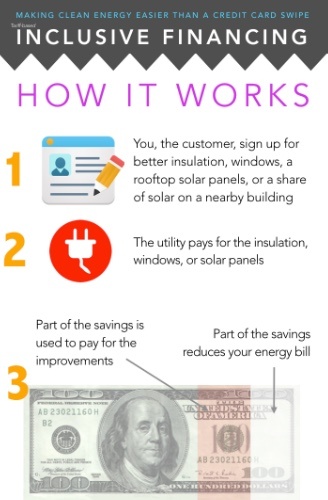 Incentives and Financing
Incentives and Financing
There are a range of incentives and financing tools for deploying charging infrastructure. State and federal incentives (the latter now expired) to subsidize at-home charger installations defray the cost for individuals, or could be passed directly to the utility to support greater deployment of public charging infrastructure. Some utilities offer rebates for chargers — the Los Angeles public utility, for example, offers a $500 rebate for a Level 2 charger and an additional $250 for those that install a second meter to access the time-of-use rate.
In California, property owners can tap into Property-Assessed Clean Energy (PACE) financing to pay for charging hardware and installation. In general, the program allows them to borrow funds for efficiency and renewable energy-focused upgrades, repaid through city-managed property tax assessments. Local governments in Florida, for example, have leeway to provide drivers with financing for eligible costs. Massachusetts, on the other hand, set aside grants to finance the equipment.
Utilities have also introduced tariff-based inclusive financing to pay the upfront cost of energy saving investments on private property, with costs recovered similar to how costs for power plants are recovered. This tool could similarly be used for electric vehicle chargers, given that the improvements in both cases provide a revenue stream for repayment — for efficiency or solar, from the improvement itself, and for chargers from electricity sales revenue increased by vehicle charging.
Role of Cities
Cities can lead on installation of public charging infrastructure, as a part of fleet transformation or emissions-reduction goals. For example, if cities adopt electric vehicles for fleet use, they can set up chargers that private drivers can access in the daytime, but are used for fleet vehicles at night. Cities can also work with utilities to ensure an equitable distribution of public charging infrastructure, to accommodate drivers who may not have access to off-street parking (or an at-home charger).
Los Angeles is a leader in charging station deployment, with 724 Level 2 charging stations and 16 DC fast charging stations available for public use (the latter available for free), in service of 13,000 vehicles, as of June 2015. The city expanded charging options through a multimillion-dollar rebate program that provides free equipment to residential and commercial properties.
Electric vehicle infrastructure can provide a springboard for cities to advance overarching clean energy goals. In 2012, St. Paul, MN, became one of the first U.S. cities to debut its own charging infrastructure. Two publicly accessible solar-powered chargers marked the beginning of a bigger network build-out, anchored in a park seen as a “regional destination” for electric vehicle drivers. Federal stimulus dollars covered about 60% of total project costs, while the city and utility Xcel Energy split the rest.
An Eye Toward Autonomy
Autonomous vehicles, typically using an electric drivetrain, present a potential complication for planning charging infrastructure. If these cars become ubiquitous, they may substantially alter vehicle ownership and use patterns. For example, if autonomous vehicles could be easily and inexpensively summoned on short notice, they could spur a sharp decrease in vehicle ownership, especially for households owning second (or third) cars. This shift would have substantial implications for charging infrastructure because instead of a large vehicle fleet that’s idle for over 90% of each day, we would have thousands of vehicles in near-constant use, requiring very fast refueling. Rather than heading to home garages with 6- to 8-kilowatt chargers, these vehicles might cluster at charging depots near utility substations, where they could access a charge at 100-kilowatts or more.
Tesla, the maker of the most highly touted battery-powered cars on the market, has said all of its vehicles will be equipped with hardware needed to enable self-driving technology. In addition, the company plans to roll out its own fleet of self-driving cars and a ride-hailing service, both under the banner of the Tesla Network. In particular, the ride-hailing element (similar to Uber and Lyft) would allow Tesla drivers to rent out their vehicles and capture a piece of the ride-hailing revenue. Through an app, Tesla owners could open their self-driving vehicles at any time to people seeking rides through the forthcoming network.
Unlike the existing Uber and Lyft models, Tesla owners would not need to actually drive their cars to pick up fares. In fact, they would not even need to be in them. The model potentially opens an ample value stream for vehicle owners to financially justify Tesla ownership.
Writing to Tesla owners in a “master plan” drafted in July 2016, Tesla CEO Elon Musk said, “You will be able to add your car to the Tesla shared fleet just by tapping a button on the Tesla phone app and have it generate income for you while you’re at work or on vacation, significantly offsetting and at times potentially exceeding the monthly loan or lease cost.”
Writing in Greentech Media, Tam Hunt tabulated the possible payoff for the owners of automated Teslas, based on the $15 average hourly income for a part-time Uber driver in Santa Barbara, CA. If a Tesla owner rented their vehicle on the Tesla Network at that hourly rate for 15 hours per week, they would see $225 in weekly income, or about $964 per month.
Even subtracting $80 per month in electricity and insurance costs, plus 35% in taxes, the monthly takeaway is $504. That narrowly outstrips monthly loan payments for a Tesla Model 3 priced at $27,500 (after a $7,500 federal tax credit), with $1,000 down and a five-year loan with a 5% interest rate. Under those circumstances, Hunt estimates the “cost” of ownership is a net positive $4 per month.
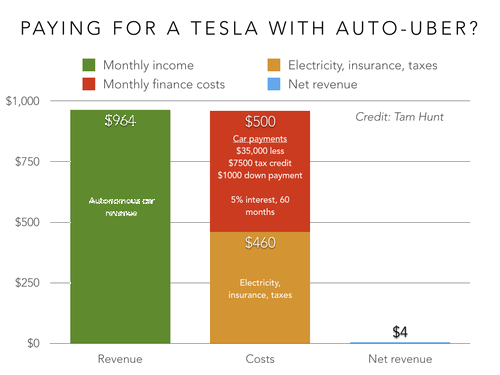
Following Hunt’s logic, and assuming regulators sign off on both the introduction of automated vehicles and Tesla’s rideshare plan, a driver with good enough credit to access favorable financing could essentially own their Tesla for free (minus a $1,000 down payment).
Will this model actually emerge? It’s unclear, but we acknowledge this complication in electric vehicle infrastructure planning and suggest policy makers remain flexible as the technology is commercially deployed.
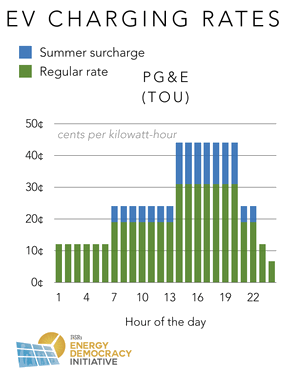 Providing Rates to Guide Charging
Providing Rates to Guide Charging
Low-cost charging rates represent the second major policy initiative for expanding electric vehicles. There’s ample evidence that utilities can use low rates to enhance grid benefits of, and customer savings from, electric vehicle charging.
Thus far, infrastructure has been a barrier.
In particular, utilities have required customers to make upfront investments in metering and charging hardware in order to access lucrative charging plans. Minnesota’s biggest power provider, Xcel Energy, provides access to lower vehicle charging rates only to customers who pay out of pocket for the installation of a second electric meter, which runs $500 to $1,500. The utility also collects from the customer a monthly $5 metering charge. As such, “only 20 EV owners out of an estimated 3,000 have signed up for the tariff,” according to comments filed with the state’s Public Utilities Commission in July 2016. Customers can instead select a standard time-of-use rate for all household use that provides an off-peak charging incentive, but that also means higher costs for daytime use of electricity for other purposes.
Pacific Gas & Electric (PG&E) offers a similar option. The installation of separate metering equipment for vehicle charging costs around $2,000, but allows customers to charge their electric car by itself on a time-of-use rate.
Other utilities provide more compelling incentives. In Maryland, PEPCO provides a time-of-use rate for electric vehicle charging and the utility pays for the required second meter.
Another Minnesota utility, Dakota Electric, identified a less expensive option. Its customers pay to install a sub-metered circuit rather than an entire second meter. This equipment typically costs between $70 and $110, with labor costs between $500 and $1,000, based on the location of the charging station and other factors, according to a utility employee. A rebate worth up to $500 helps offset some, but not necessarily all, of these expenses.
Utilities that want to capture the benefits of managed charging need to provide mechanisms, incentives, and financing that makes sense for customers. Utilities that have made managed charging possible do see benefits.
A Sacramento utility tested a pricing plan with three time-varying options, and found it shifted as much as 10% of its peak load to other periods. Sacramento’s Municipal Utility District has also offered a “charge free for a year” promotion, valued at $300 per vehicle, and provided public fast-charging stations.
The movement toward better charging policies is underway, albeit slow-moving. By June 2015, 28 utilities in 15 states had implemented tariffs that address electric vehicle charging. The measures can support power providers and reward drivers whose habits align with grid needs.
Minnesota, a major wind-producing state that in 2014 required its large utilities to add electric vehicle tariffs, has proven fertile testing ground for overnight charging incentives. According to the requirement, each utility designs its own electric vehicle tariff. Though each tariff is distinct, common elements include the required installation of new charging hardware and steep overnight charging discounts.
Tariffs for two of Minnesota’s largest electric utilities are shown in the chart below. As noted previously, Xcel Energy requires installation of a full second meter to access its electric vehicle rate while Dakota Electric offers a sub-metering option.
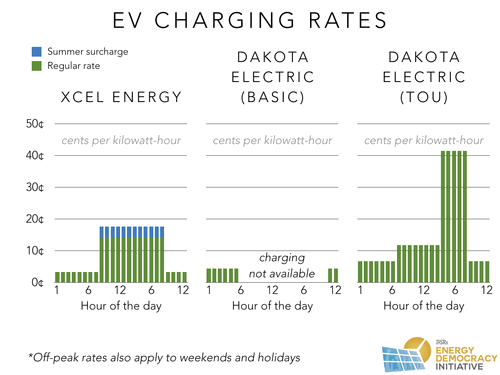
For utilities that lack off-peak charging rates, however, utility commissions or state legislatures should require their adoption given the widespread, proven benefits.
Charging from Utility or Self-Supplied Renewable Energy
As discussed previously, renewable energy and electric vehicles are a powerful match, because discretionary charging can cater to variable supply. In some parts of the country, overnight charging dovetails with better overnight wind energy production and in others parked electric vehicles can help absorb noon-time solar energy production.
Utilities are inconsistent in their approach to unlocking these potential benefits. Xcel Energy in Minnesota does not offer a discount for charging from renewable energy, but rather charges the same premium for its Windsource program to all users. In contrast, cooperative utility Great River Energy (also in Minnesota) offers wind fueling at no extra charge.
Minnesota cooperative utility Great River Energy offers wind fueling at no extra charge. The utility also plans to implement incentives for customers charging infrastructure, and help electrify schools buses.
The availability of midday charging options also helps alleviate range concerns. In a rollout of public charging stations, San Diego Gas & Electric Co. will provide special rates that reward drivers who plug in when renewable energy generation is most abundant. Marin Clean Energy, also in California, offers a rewards program for customers who plug in during afternoon hours. In another sun-rich state, the Hawaiian Electric Companies in 2015 unveiled rates that are lowest between 9 a.m. and 4 p.m., when solar production is highest.
Utility pricing plans can also encourage on-site use of solar.
A Hawaiian Electric Company program launched in summer 2016 makes solar charging a logical option for electric vehicle owners who can charge at home during daylight hours. Born of a transition away from net metering, customers with solar have two choices: provide excess power to the grid and receive credits worth about half the retail price for electricity, or retain all of their solar electricity for on-site use. Customers using the “self supply” option cannot feed power back onto the grid, though they can capture the full value of their solar electricity (by offsetting electricity that otherwise costs $0.25 to $0.35 per kilowatt-hour) instead of selling it to the utility at about half that price.
The program aligns with 2015 findings from the Rocky Mountain Institute that together with batteries and smart appliances designed to help households better manage energy, electric vehicles could drive a 50% to 90% increase in on-site solar consumption.
In New York, a reworked algorithm for the value of distributed solar sets up a system that also favors greater on-site electricity use, such as charging an electric vehicle. The “transparent pricing” structure values distributed energy based on its location, plus its benefits to the grid and the environment. The adjusted calculus is part of a transition away from traditional net metering.
No matter what, New York households with solar will net less revenue than they would have with net metering, but assuming the “transparent price” will be lower than the retail net metering credit, households that use more of their distributed generation on site will squeeze more value from their arrays.
Assuming two Empire State families each have a 5-kilowatt solar array that produces 7,000 kilowatt-hours per year, the relative costs and benefits vary, as illustrated below. In both cases, we assume that net metering provides $0.18 per kilowatt-hour in compensation, while the “transparent price” is just $0.14.
If one family uses just 30% of the electricity it generates and sends the rest to the grid, the new system would not deliver as much value as the longstanding net metering framework that paid full retail value for the generation. That means if the other family uses 70% of its electricity on site, it preserves more value. Charging electric vehicles at home is one way to significantly boost on-site usage.
In the long run, utilities should work in partnership with charger manufacturers and automakers to allow vehicle charging to follow renewable energy supply. More immediately, utilities should offer financial incentives (in the form of price discounts) to customers that encourage vehicle charging when there’s ample supply of renewable energy.
Deliberate Resource Planning
Utilities typically produce 15-year or longer “resource plans” to map out additions of new power plants and power lines that will last for decades. This is their “planning horizon.” But electric vehicles may have an impact much sooner than the 40-year lifetime of these traditional resources, or even the 15-year timeframe of resources plans. In other words, the timing of electric vehicle policy is as important as the magnitude of vehicle adoption, and the rising numbers of electric cars on U.S. roads may impact utility plans well within their current planning horizon.
At least one utility, the Sacramento Municipal Utility District, is already laying the groundwork in its planning, which includes:
- Modeling potential vehicle adoption
- Planning and deploying public charging infrastructure
- Providing incentives for electric vehicle adoption
- Advertising and conducting outreach to customers about electric vehicles
- Expanding the utility’s fleet of electrified light- and heavy-duty vehicles
- Supporting electrification of public fleets, such as school buses
- Researching charging controls
In most states, Public Utilities Commissions will play a crucial role, as they oversee utility resource plans. Minnesota’s Commission, for example, opened a docket to explore distribution-level resource planning. California regulators launched a rulemaking process in 2014 to implement a new law requiring distribution-level planning. It’s an ongoing proceeding, but already requires utilities to provide a public “hosting capacity” analysis of their distribution grids to determine where distributed energy systems could readily leverage existing capacity.
Increasing Access to Electric Vehicle Ownership and Benefits
As electric vehicle adoption grows, there’s an issue of allowing people who do not own a vehicle or for whom the cost premium is prohibitive to enjoy the benefits. This can include means-tested incentives for purchasing vehicles, public charging infrastructure near multi-family housing, and electrifying car-sharing and public transit fleets.
Before considering targeted policies, it’s worth noting that electric vehicles have every hallmark of technology diffusion like computers or smartphones. In other words, early adopters tend to be wealthy, but the increasing production driven by these first movers lowers the price for new entrants. The following two charts illustrate this dynamic for smartphones, where ownership has more than doubled in five years while costs — of non-Apple devices — have dropped by nearly half.
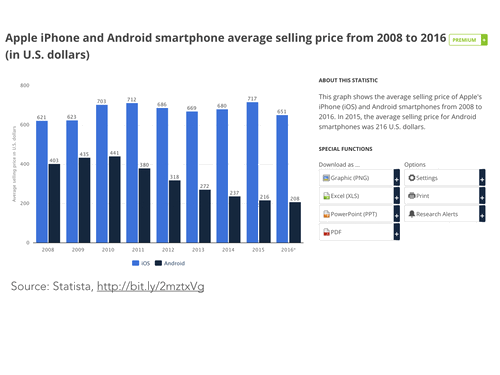
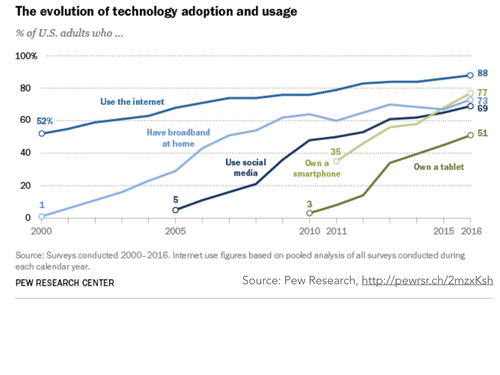
Electric vehicles can save their owners money through reduced fuel and maintenance costs — and by potentially helping to balance the grid during peak demand times — but new electric cars still require a substantial upfront investment. The average new electric car costs $36,000, although that can be reduced with the $7,500 federal tax credit. The secondhand market may already provide opportunities, however, with two-year old Nissan Leafs selling for under $15,000.
Pioneering legislation at the state level, most notably in California, has begun to expand the field of prospective new electric vehicle owners. In late 2016, the state’s Clean Vehicle Rebate Project increased benefits available for lower-income households and excluded high-income earners — households with income exceeding $300,000, who had been capturing most of the program’s benefits. The changes allow eligible households to claim $2,500 for buying or leasing a battery-powered vehicle, or $1,500 for choosing a plug-in hybrid. For lower-income households — a family of four earning less than $73,000 per year — the rebate amounts increase by $2,000.
Even with means-tested incentives, electric vehicle owners need access to charging infrastructure. GIven that lower-income users disproportionately lack a private garage or carport for charging, public chargers near multi-family dwellings are particularly important. In California, several investor-owned utility charging infrastructure programs set minimum targets for deployment in low-income areas. San Diego Gas & Electric Co. plans to install 3,500 total public chargers and place 10 percent of them in disadvantaged communities.
There are additional ways to provide the benefits of vehicle electrification, even to households that can’t afford or don’t require a vehicle. Encouraging electric vehicle use in car sharing programs, for example, can provide access to those who don’t own a vehicle. The City of Los Angeles is using funds from California’s cap-and-trade program to finance an electric car-sharing program catering to low-income communities. A similar program will provide eight electric vehicles near subsidized housing projects in Sacramento.
Electrification of public transit can save transit agencies money while benefiting communities that carry a disproportionate share of the health and environmental costs of diesel emissions. The newest Proterra E2 electric bus, for example, costs $250,000 to $300,000 more than a comparable diesel bus, but cut $275,000 in fuel costs and $400,000 in maintenance costs over its lifetime (other estimates show the savings for the latter closer to $160,000, which is still a 30-40% savings over a diesel bus).
Electrifying bus fleets also substantially reduces air pollution, including the particulate matter that contributes to respiratory illnesses, heart disease, and other conditions. A Columbia University analysispublished in 2016 for New York City Transit estimates that a full diesel-to-electric transition for that city’s 5,700 buses would reduce particulate matter emissions by 97.5%, assuming each bus travels 27,600 miles per year and uses roughly 10,000 gallons of fuel.
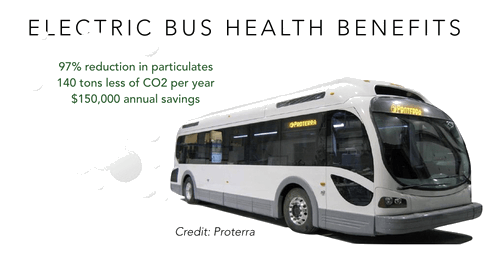
Factoring in costs associated with hospitalization, emergency room visits, and absences from work, the health benefits of the diesel-to-electric switch deliver annual cost savings worth about $150,000 per bus, a total of over $850 million. Each zero-emission bus also eliminates 1,690 tons of carbon dioxide over its average 12-year lifespan — the equivalent of removing 27 cars from the road, according to U.S. Department of Transportation figures.
Promoting Vehicle-to-Grid
There are several major challenges to broader adoption of vehicle-to-grid technology: lacking industry standards for software and hardware, market rules and tariffs, infrastructure, friendlier vehicle warranties, and cyber-security. This section will detail the roadblocks, but with the caveat that electric vehicles offer substantial opportunities even without vehicle-to-grid availability. (More on vehicle-to-grid technology is in Appendix A).
Fundamentally, the technology is caught in a problematic loop: manufacturers don’t build compatible features into their electric vehicles because there isn’t yet a market for them, but there isn’t a market because the features aren’t yet available. German automaker Daimler Mercedes-Benz has installed related software in its electric vehicles, for example, enabling them to control charging in a way that helps balance the grid. But until German utilities integrate the technology into their grids, it cannot achieve its potential. A standard adoption agreement between utilities and carmakers is likely necessary to jumpstart implementation. Such a pact would require parties on both sides to incorporate the technology into their suite of offerings within a given timeframe.
Cooperation between auto manufacturers and regulators is also needed. As it stands, car manufacturers largely do not allow vehicle-to-grid use under their warranties. Given limited experience with electric vehicle batteries, few consumers would be willing to test money-making opportunities on the grid if it risks coverage of their primary mode of transportation.
Market regulations need to better accommodate mobile power-delivery and storage resources, lowering limits for participation or making it easier to bundle electric vehicles to be a viable source of ancillary services for utilities. In PJM’s Eastern regional grid territory, for example, market participants only need 100 kilowatts of capacity, energy, or ancillary services. In MISO’s Midwest territory, on the other hand, there isn’t even a market yet.
In 2016, CAISO evolved its requirements to better match a more diverse, and increasingly distributed, energy mix. Where it had previously set a 500-kilowatt threshold for wholesale power market participation, it won approval for a new framework that allows smaller distributed energy resources to bundle together to meet that threshold. The New York Independent System Operator (NYISO) allows for similar aggregation to reach a 1,000-kilowatt minimum threshold for participation in its demand response programs.
Specially designed tariffs would help grow and maintain the electric vehicle market, especially considering that a V2G model encourages drivers to plug in their vehicles often to make them available to provide grid services.
Charging infrastructure must be accessible at homes and offices, so vehicles are consistently available when the grid operator needs them. There are relatively few chargers in either place yet, and almost none equipped for two-way services. This infrastructure also needs the capability to exchange regular and frequent data with the grid about its needs.
Cybersecurity protection for drivers and grid, who would share data, is also necessary. As vehicles become increasingly networked, they also grow more vulnerable. Until now, connectivity features now commonly installed in vehicles — from remote diagnostics to GPS — have invited little interference outside controlled experiments on willing participants. But the specter of unplanned breaches, particularly as the marketplace relies more on shared wireless technology, prompted Congressional action in 2015 to establish federal safety standards to protect privacy and safety.
Unlocking vehicle-to-grid as a regulation and storage resource will not impose significant technological challenges on the existing grid, though it will require the aggregation of hundreds or thousands of vehicles in a given area in order to create a sizable enough power source to capture utility and grid operator interest. Regulators can help create this market by working with utilities and carmakers to get the rules and the infrastructure in place.
Summary of Recommended Policies
Infrastructure
- Utilities should finance private chargers and invest in public charging networks based on future revenue from sales of electricity to power vehicles (and/or implement inclusive, tariff-based on-bill financing). Regulators should ensure choice and competition in charging hardware for private and public chargers.
- Public charging infrastructure should be well distributed geographically and equitably, especially in areas where private parking and charging is less available, such as near multi-family housing and business districts.
- Cities should allow residents and businesses to use Property Assessed Clean Energy (PACE) financing for electric vehicle charging hardware, and also lead by example by electrifying fleet vehicles and providing public access to fleet charging stations.
Charging
- Utilities should offer charging plans that include substantial discounts for charging during off-peak hours or absorbing excess renewable energy supply.
- Utilities should lower barriers (such as hardware and installation costs) to accessing discounted charging programs.
- Utilities, charger manufacturers, and automakers should harmonize technology to allow for vehicle charging to follow and accommodate renewable energy supply.
- Cities should work with utilities and car dealers to offer bundled solar and electric vehicle purchases, and deploy policies to support on-site charging from solar.
Incentives and Access
- Electric vehicle incentives should be means-tested.
- Car-sharing and transit systems should be electrified due to widespread health and environmental benefits.
Conclusion
Electric vehicles represent a titanic shift in the transportation sector, a back-to-the-future moment where battery-powered vehicles can reclaim the position of most popular drivetrain. Their adoption has many significant implications, from the decarbonization of transportation by enhancing renewable electricity use, to widespread opportunities to improve electric grid efficiency with distributed energy storage.
Electric cars also spark energy democracy, aiding the adoption of greater local renewable energy production and miniaturizing electricity grids by giving communities control over their power when the larger grid is up or goes down. The increase in local authority and power generation from electric vehicle deployment will charge local economies along with their vehicle fleet.
The most important lesson is that doing nothing — especially in the near term — will inflict minimal harm from the perspective of grid operations and costs. Given common charging practices and limited numbers, electric vehicles won’t substantially impact the electricity system for several years.
Still, we stand at an inflection point.
The electric vehicle is like a wheeled shipping container of disruptive technology. Its electric drivetrain is incredibly efficient, requires much less maintenance, and lasts much longer than an internal combustion engine. It can fuel for as little as one-tenth the cost of a gasoline vehicle per mile. It can provide other functions, including backup power to the owner’s home and ancillary grid services. And its only high-cost component, batteries, are falling in price rapidly as production accelerates.
Given these features, electric vehicle adoption is likely to follow the technology adoption “S curve,” reinforced by a variety of technologies (and shown below).
With exponential growth likely ahead and utility planning horizons extending 15 to 40 years, the time to adopt the right policies is now.
In order for communities to fully capture the benefits electric vehicles can deliver, regulators and utilities across the U.S. need to begin rolling out policies and programming to promote electric vehicle ownership, incentivize charging at times that make sense, build up necessary charging infrastructure, and set standards for vehicle-to-grid connections.
With exponential growth likely ahead, the time to adopt the right policies is now.
In particular, to capture the energy democracy opportunity, we need universal accessibility to electric vehicle benefits. We need policies like inclusive financing to provide both public and private charging infrastructure. We need to electrify public and private fleets to widely share the localized environmental and health benefits of switching from oil to electricity. We need charging policies that lower the cost to charge as electric vehicles lower the cost of grid operations. We need charging policies that amplify local benefits, such as maximizing local solar generation. We need incentives that allow people at many income levels to participate.
Electric vehicles will upend the transportation system — and soon — and provide new ways for communities to take charge of their energy future. With appropriate planning, communities across the country can parlay the proliferation of electric vehicles into a cornerstone of a local energy economy.
Read the full report online, here. For timely updates, follow John Farrell or Karlee Weinmann on Twitter or get the Energy Democracy weekly update.
Photo Credit: Micadew via Flickr (CC 2.0) & Nissan.

Chip in a few dollars a month to help support independent cleantech coverage that helps to accelerate the cleantech revolution!
Have a tip for CleanTechnica? Want to advertise? Want to suggest a guest for our CleanTech Talk podcast? Contact us here.
Sign up for our daily newsletter for 15 new cleantech stories a day. Or sign up for our weekly one if daily is too frequent.
CleanTechnica uses affiliate links. See our policy here.
CleanTechnica's Comment Policy

